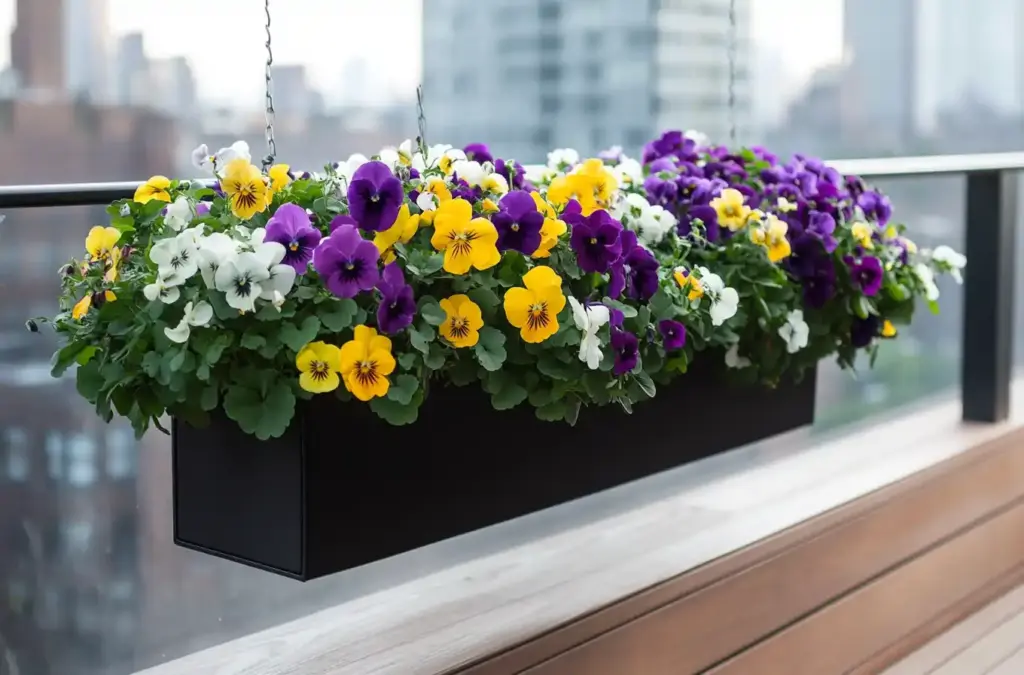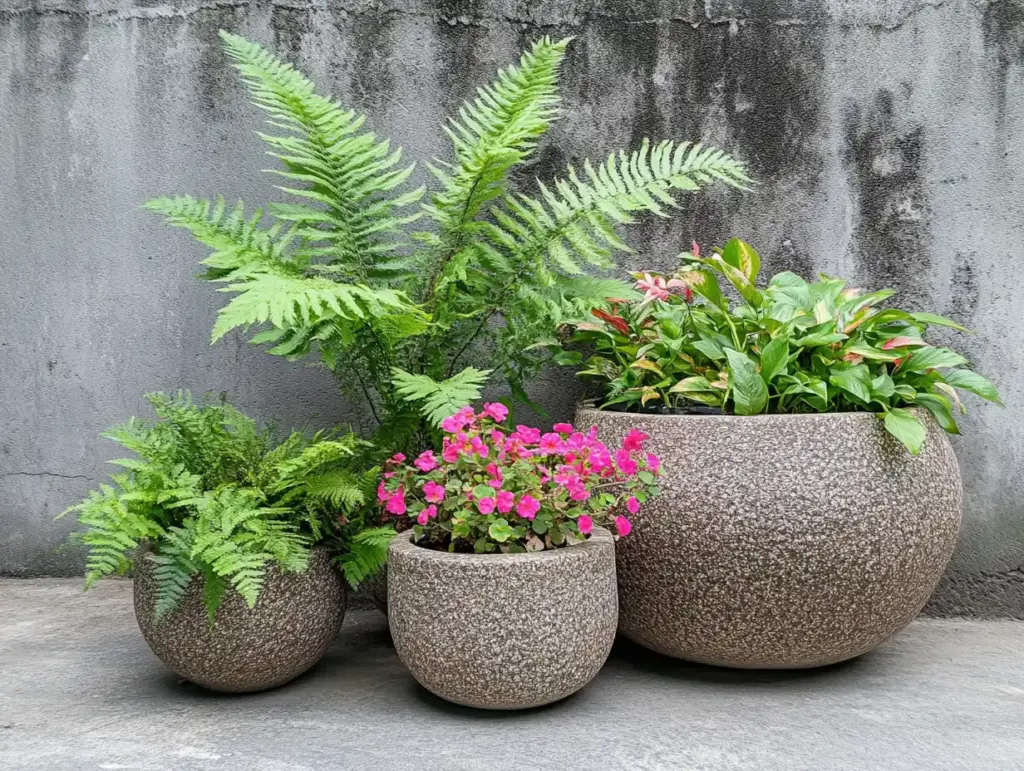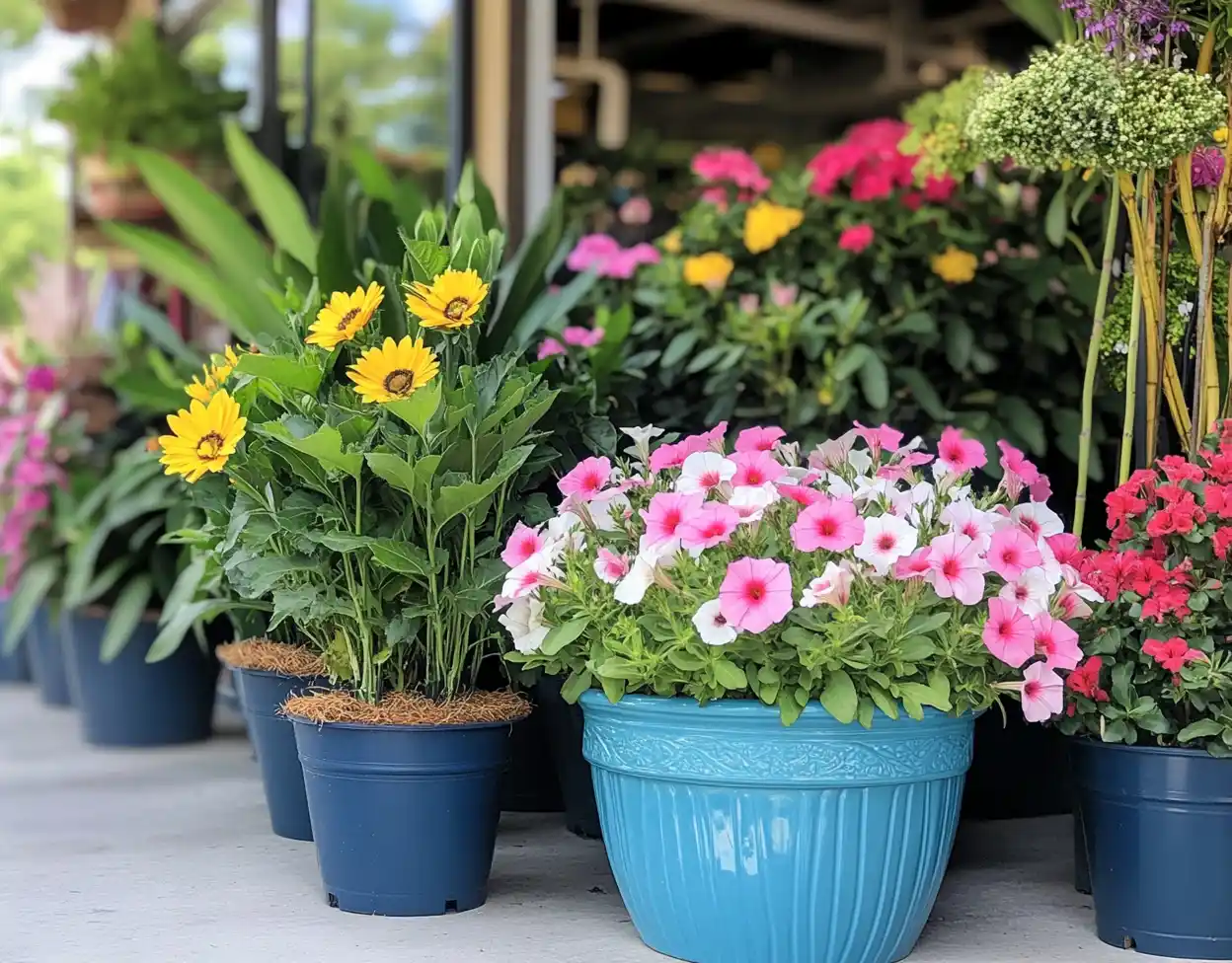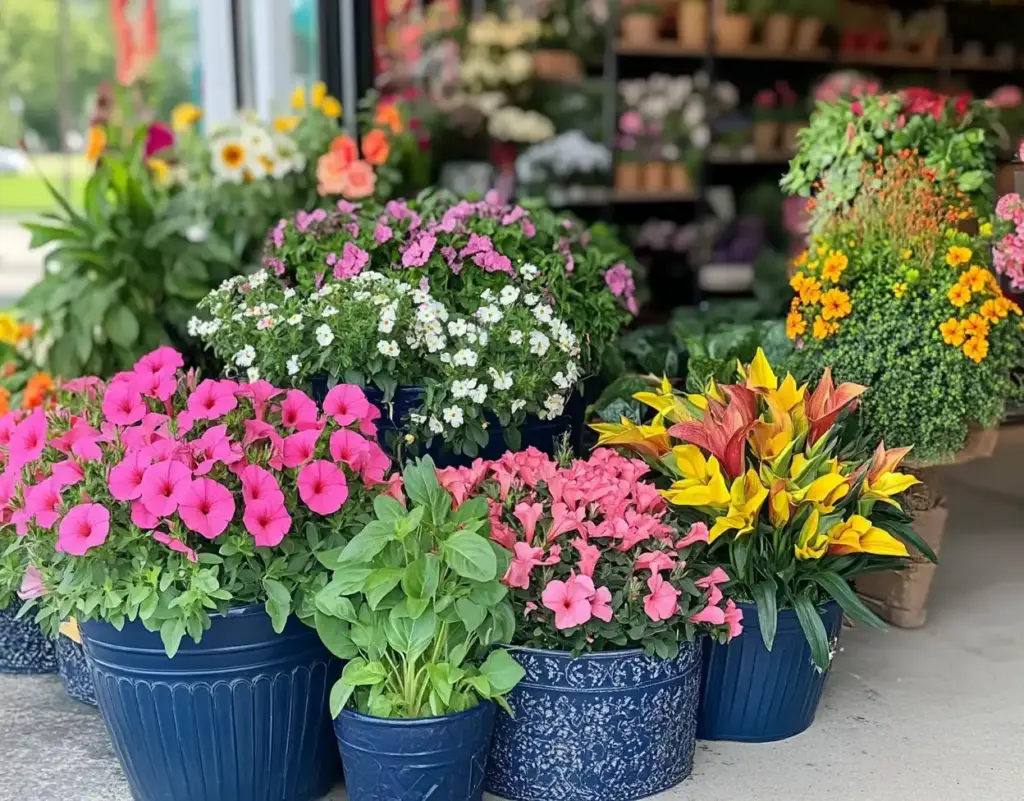As the vibrant blooms of summer fade and cooler temperatures creep in, many gardeners begin to ask the same question: What should I do with my front porch flower pots this winter? These containers bring so much beauty and personality to your porch during the warmer months, but they require a bit of winter prep to stay healthy and thriving.
Fortunately, front porch flower pots don’t have to be tossed or ignored when frost arrives. With a little planning, you can extend their beauty year-round. By choosing the right cold-hardy potted plants and knowing when to bring tender varieties indoors, you can protect your investment and enjoy greenery even in the colder months.
In this guide, we’ll explore the best ways to winter-proof your front porch flower pots—from selecting the most durable containers to caring for each plant type with confidence. Don’t miss our sunny porch plant ideas if you’re planning ahead for next season, too!
Table of Contents
🌿 1. Plants to Bring Indoors for Winter
Not all plants are built to handle freezing temps. If your front porch flower pots include tropical or tender varieties, it’s time to make room indoors.
Tropical and Tender Plants to Relocate Inside:
These warm-weather lovers won’t survive frost and should be moved indoors before nighttime lows drop below 45°F:
- Calla lilies – Store in pots or as dormant tubers.
- Canna – Dig and dry rhizomes or grow indoors as houseplants.
- Ginger – Likes indirect light and moderate humidity indoors.
- Gladiolus – Uplift corms and store in cool, dry areas.
- Palms – Many varieties adapt well to indoor life.
- Citrus trees – Enjoys bright light and weekly watering indoors.
Popular Ornamental Favorites:
These flowering or foliage plants often grace front porch flower pots and deserve indoor protection in winter:
- Hibiscus – Prefers bright, sunny windows.
- Geraniums (Pelargoniums) – Allow to go semi-dormant or keep blooming with proper care.
- Begonias – Moisture-sensitive but excellent for indoor growth.
- Mandevilla – Needs filtered light and occasional pruning.
- Oleander – Toxic to pets but hardy indoors in bright light.
- Caladium – Store bulbs dry or keep in warm, humid rooms.
- Angel’s trumpet – Dramatic blooms but requires ample indoor space.
Don’t Forget the Foliage:
- Succulents & Coleus – Both do well in sunny indoor spaces; reduce watering in winter.
- Herbs – Especially parsley, basil, rosemary, and mint transition well to kitchen windowsills.
Pro Tip: If your space is tight, prioritize plants based on value, appearance, or rarity. Alternatively, choose varieties for your front porch flower pots that match your USDA zone’s average winter lows
🌲 2. Cold-Hardy Plants That Can Stay Outside
Not all front porch flower pots need to migrate indoors. Some plants are built tough—able to survive (and even thrive) through chilly weather when given proper care and positioning.
Here are some container-friendly champions that can stay outside all winter long:
Evergreen Shrubs That Shine Year-Round:
- Japanese yew & Brown’s yew
These drought-tolerant evergreens offer rich green foliage throughout winter. Ideal for sunny or partly shaded porches, they add structure and color even when everything else looks bare. - Potted blue spruce
With silvery-blue needles and a festive shape, this evergreen doubles as a holiday display. It thrives in full sun and appreciates evenly moist, well-drained soil. Just ensure your container has proper drainage to avoid root rot. - Cypress topiaries
Sculpted beauties that love morning sun and filtered afternoon light. Avoid overwatering—these elegant evergreens are sensitive to soggy soil. - Boxwoods
A classic for formal porches, boxwoods tolerate the cold well when given weekly watering and full sunlight. Their dense foliage also adds winter interest.
Cool-Weather Bloomers for a Touch of Color:
- Violas
These charming flowers can bloom through snow with the right setup. Keep violas in pots with excellent drainage and pinch back spent blooms to encourage ongoing flowering. - English primrose
Available in a variety of hues, primroses bloom in cool conditions and tolerate winter sun. Regular watering helps them perform best during colder months.
Front porch flower pots don’t have to look barren in winter. By choosing the right cold-hardy plants, your porch can stay lively—even under a dusting of snow.
🪴 3. Best Winter Containers
Choosing the right container is just as important as selecting the right plants—especially when winter weather comes into play. Your front porch flower pots need to stand up to freezing temperatures, moisture, and potential snow or ice buildup without cracking or deteriorating.
🧱 Recommended Winter-Resistant Containers:
These materials offer insulation, durability, and resistance to the freeze-thaw cycle:
- Fiberglass – Lightweight but tough, and resistant to cracking.
- Iron – Heavy and durable, ideal for anchoring taller plants on windy porches.
- Stone – Natural insulation and timeless aesthetics make it a solid pick.
- Concrete – Excellent at protecting roots and doesn’t shift with temperature fluctuations.
- Heavy plastic – Budget-friendly and lightweight, yet surprisingly resilient when thick-walled.
Look for double-walled designs to help insulate roots from extreme cold.
⚠️ Containers to Avoid in Winter:
Some common pot materials just aren’t built for winter. If you’re using these for your front porch flower pots, consider moving them indoors or swapping them out:
- Terra cotta – Absorbs water, which freezes and expands, leading to cracks.
- Unglazed ceramic – Vulnerable to chips and water infiltration, causing breakage during freezing weather.
- Hanging baskets – Dry out quickly and offer little root insulation, making them a poor choice in winter.
Tip: If you’re committed to a specific container style, place it inside a larger, winter-hardy pot to shield it from the elements.
🛡 4. Winter Protection Tips

Even the hardiest front porch flower pots can struggle without the right winter prep. Freezing temps, fluctuating moisture levels, and strong winds all take a toll on plants and containers alike. Fortunately, a few simple strategies can keep your porch garden safe and healthy until spring.
💧 Watering Wisdom for Winter
- Avoid overwatering – Cold slows down plant growth, which means they don’t need nearly as much water. Overly wet soil can freeze and damage roots.
- Use well-draining soil – Waterlogged containers are a recipe for root rot, especially in freezing conditions.
- Don’t leave pots in saucers – Trapped water can freeze and crack both the saucer and the base of your container.
🧣 Insulating Roots from Cold
Your plant’s survival often depends on how well its roots are protected:
- Use larger pots – Bigger containers retain heat better and offer more insulation to the root zone.
- Wrap your pots – Insulate containers with burlap, bubble wrap, or old blankets to keep the cold out.
- Bury containers in the ground – If possible, dig a hole in your garden, place the pot inside, and cover the sides with mulch or soil. This creates a micro-climate that buffers against temperature swings.
For those keeping front porch flower pots above ground, clustering them together can help create a pocket of warmth and reduce exposure to icy winds.
⏰ 5. When to Bring Plants Indoors
Timing is everything when it comes to saving your seasonal favorites. Bringing your front porch flower pots indoors too late could mean frost-damaged leaves—or worse, dead roots. To avoid that, it’s important to stay ahead of the weather and know your plant hardiness zone.
⏳ Watch the Forecast
- Move plants indoors before the first frost
Most tender plants start to suffer when nighttime temperatures dip below 45°F. If you’re unsure when that might happen, start monitoring your local weather in late fall. - Use the USDA Plant Hardiness Zone Map
This handy tool helps you determine the average minimum temperatures in your area—and which plants are suited to survive them. If your plant isn’t rated for your zone’s winter lows, it likely needs to be brought indoors. - Avoid last-minute moves
A sudden drop in temperature can catch even seasoned gardeners off guard. Prepping early allows plants to adjust gradually, minimizing shock.
🍁 Signs It’s Time
- Daylight hours begin to noticeably shorten
- Nighttime temps hover in the mid-40s (°F) or lower
- Your warm-weather plants stop blooming or begin to drop leaves
Front porch flower pots filled with tropical or annual plants should be first on your list to move inside—don’t wait for frost to do the damage.
🏠 6. How to Store Plants Indoors

Once your front porch flower pots have been brought inside, they’ll need some time to adjust to their new environment. Indoor conditions—lower light, drier air, and warmer temperatures—can be stressful for plants accustomed to outdoor life. With proper care, though, your greenery can transition smoothly and stay healthy all winter long.
🌡 Step-by-Step Transition Tips
- Let plants acclimate
Before placing them directly in your living room, let them spend a few days in a transition space like a garage, sunroom, or enclosed porch. This helps them slowly adjust to changes in humidity and light. - Maintain the right temperature
Most plants do best indoors at 55°F to 70°F. Avoid placing pots near heaters, drafty windows, or doorways that cause sudden temperature swings. - Provide ample light
Many front porch flower pots contain sun-loving plants. Indoors, place them near south-facing windows or supplement with grow lights if natural light is limited. - Avoid pet hazards
Keep plants out of reach of curious pets, especially if you’re overwintering toxic varieties like oleander or angel’s trumpet. Even non-toxic plants can cause mild stomach upset if chewed.
Pro Tip: Clean plant pots before bringing them in. Wipe down the exterior and rinse off any debris or bugs that may have hitched a ride.
🌱 7. Indoor Plant Care Tips
Now that your front porch flower pots are safe and warm inside, it’s time to switch gears from outdoor maintenance to indoor plant care. Overwintering doesn’t mean “hands-off”—your plants still need attention, just in different ways.
💧 Water Wisely
- Only water when needed
Indoor plants typically need less water during winter. Wait until the top inch of soil feels dry before watering again. - Avoid soggy soil
Too much moisture can lead to root rot, especially when sunlight is limited. Always use pots with drainage holes.
🍂 Expect Some Leaf Drop
- Don’t panic if leaves fall
Many plants go semi-dormant or drop older leaves while adjusting to indoor conditions. New growth will often return once they acclimate. - Rotate plants
To prevent leaning toward the light, turn pots a quarter turn every week or two. - Check for dust
Dusty leaves block sunlight. Wipe leaves gently with a damp cloth every few weeks to help your plant breathe and photosynthesize more efficiently.
Front porch flower pots can continue to thrive indoors with just a few adjustments. Think of it as seasonal self-care for your favorite plants!
🐛 8. Prevent Pests Indoors
Bringing your front porch flower pots indoors doesn’t just mean cozying up your plants — it also risks inviting unwanted guests. Without natural predators, pests like aphids and fungus gnats can spread quickly and affect all your indoor greenery.
🕵️♀️ Common Indoor Plant Pests
Leaf-Dwelling Pests
These critters tend to hide under leaves or along stems:
- Aphids
- Spider mites
- Mealybugs
- Whiteflies
- Scale insects
- Lacewings (beneficial outdoors, but not indoors!)
Soil-Dwelling Pests
These lurk in potting mix and near drainage holes:
- Slugs
- Fungus gnats
- Ants
- Earwigs
🧼 How to Prevent and Remove Pests
- Rinse foliage before bringing plants indoors
Use a gentle spray of water to wash off any visible bugs, especially from the undersides of leaves. - Inspect and isolate
Keep newly moved plants in “quarantine” for 7–10 days away from other indoor plants. Watch for signs of infestations before integrating them into your main space. - Use insecticidal soap or neem oil
Apply if you spot persistent pests. Be sure to follow the label and treat both leaves and soil surface. - Check drainage holes
Soil pests often hide here. Flick off visible bugs manually or treat with a soil-safe insecticide.
Prevention is key: One unnoticed infestation in your front porch flower pots can spread quickly to other houseplants.
🌼 9. Moving Plants Back Outdoors in Spring
As winter loosens its grip and sunshine returns, it’s tempting to rush your front porch flower pots back outside. But patience and gradual reintroduction are essential for preventing transplant shock and sunburned leaves.
🌤 When It’s Safe to Transition Back
- Wait until nighttime temps consistently stay above 45°F
Sudden cold snaps can damage tender new growth, even if daytime highs feel spring-like. - Watch for signs of new growth
If your indoor plants begin putting out fresh leaves, they’re likely ready for outdoor conditions — but only if temps allow.
☀️ How to Reintroduce Plants Outdoors Safely
- Start in a shaded or partially shaded spot
After weeks or months indoors, plants need time to readjust to direct sunlight. Begin in dappled light for 4–7 days. - Gradually increase sun exposure
Move your containers to sunnier areas over a 1–2 week period to avoid scorching. - Boost watering frequency
Outdoor air is often drier and windier. As temps rise, your plants will drink more — check soil moisture daily. - Inspect for pests again
Before placing plants near others outdoors, inspect for any lingering insects or mold issues.
Your front porch flower pots are about to shine again — just give them time to re-acclimate, and they’ll reward you with vibrant color and growth through spring and summer.
🌟 Conclusion
Front porch flower pots aren’t just seasonal eye candy — they’re living, lasting investments in your home’s curb appeal. With a bit of preparation, your front porch flower pots can thrive throughout winter and bounce back in spring even stronger. Whether you’re bringing in tropical plants, insulating evergreens, or selecting winter-proof containers, understanding how to protect your pots in cold weather is key to long-term success.
Looking to upgrade your outdoor setup before next season? Check out our planters for front porch makeover ideas and 16 best potted plants for porches for design inspiration. You might also love these summer front porch décor ideas to refresh your containers once the weather warms up.
With thoughtful care and seasonal adjustments, your front porch flower pots won’t just survive winter — they’ll thrive, season after season.
❓ Frequently Asked Questions
Can front porch flower pots stay outside all winter?
Yes, but only if they contain cold-hardy plants and are placed in winter-resistant containers like fiberglass, concrete, or stone. Tender tropicals should be moved indoors before the first frost.
What temperature is too cold for front porch flower pots?
Most tropical and annual plants suffer below 45°F, and a hard freeze (28°F or lower) can kill roots. Monitor your local forecast and move sensitive plants inside early.
How do I know if my potted plant needs to come indoors?
If it’s a tropical, tender perennial, or herb not rated for your USDA zone’s minimum temps, it needs indoor shelter. Check your plant tags or research specific varieties.
What’s the best way to keep front porch flower pots from freezing?
- Use large, insulated containers
- Avoid water-absorbing pots like terra cotta
- Group pots together
- Wrap pots in burlap or bubble wrap
- Elevate containers to prevent cold transfer from concrete
Can I leave ceramic pots outside in winter?
Not recommended. Most ceramic pots—especially unglazed—crack easily in freezing weather due to water absorption and expansion. Bring them inside or use as decorative covers over winter-proof liners.
How do I prevent pests when bringing plants indoors?
- Rinse leaves and stems with water
- Inspect soil and drainage holes
- Quarantine new arrivals for 7–10 days
- Use neem oil or insecticidal soap as needed
When can I move front porch flower pots back outside in spring?
Wait until nighttime temperatures consistently stay above 45°F. Acclimate plants slowly by starting in partial shade and increasing sun exposure over 1–2 weeks.


